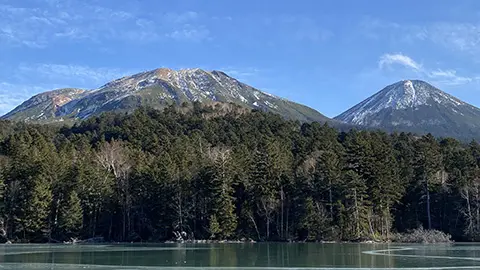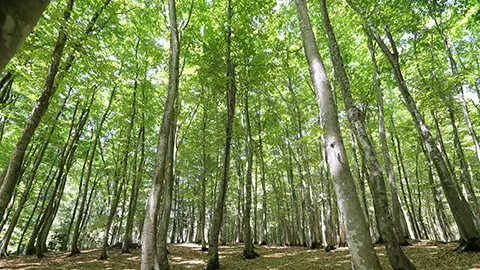VOL.192 MAY 2024
JAPAN’S HEALING FORESTS (PART 1)
The Forests of Shirakami-Sanchi, Japan’s First World Natural Heritage Site
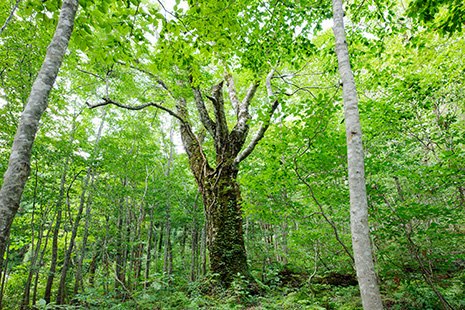
A 400-year-old Japanese Beech tree — the symbol of the Shirakami-Sanchi Mountains
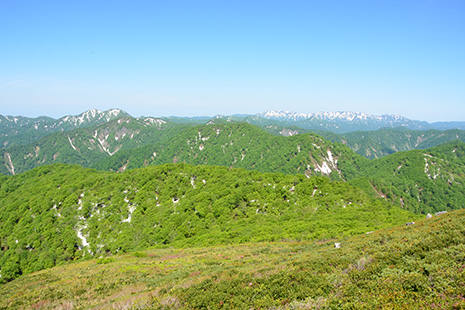
Shirakami-Sanchi World Heritage Site as seen from the summit of Mt. Kodake (elevation: 1,042 m) in Fujisato Town, Akita Prefecture
Photo: Shirakami-Sanchi World Heritage Conservation Center
The mountains of Shirakami-Sanchi, the first place in Japan to be inscribed as a UNESCO World Natural Heritage site,* represent one of the earth’s rare places. Here, large area of primeval natural forest, mainly Japanese Beech, have remained in a “pure forest”** state. We asked Shiratori Mari of the Shirakami-Sanchi World Heritage Conservation Center to tell us about the site.
The Shirakami-Sanchi World Heritage Conservation Center, Fujisato-kan,*** which is located at the southern foot of the Shirakami-Sanchi Mountains, is a facility where visitors can learn more about the significance of the World Natural Heritage Site that is Shirakami-Sanchi. Shiratori, who is a resident nature advisor at Fujisato-kan, revealed the features of the Shirakami-Sanchi Mountains.
“Shirakami-Sanchi is the collective name for the mountains that straddle Aomori and Akita Prefectures in the northern part of Japan’s Tohoku region. The appearance of the mountains changes vividly from season to season, thanks to the deciduous broad-leaf beech and other trees. The forest is like being held in the cradle of life that provides our village not only with nature’s bounty such as nuts, wild vegetables, and mushrooms, but also delicious water thanks to the fallen leaves that store and filter rain and snow.”
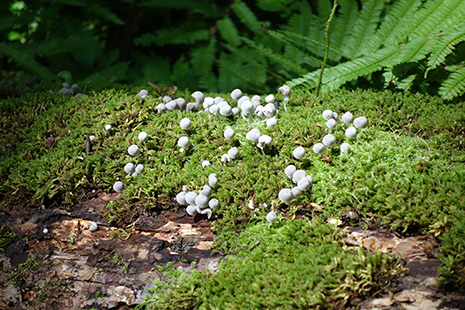
Shirakami-Sanchi is a mountainous region with elevations of 200 to 1,250 meters, covering an area of about 130,000 hectares. The roughly 17,000 hectares at the center of this area is inscribed as a UNESCO World Natural Heritage site.
“Within the vast area called Shirakami-Sanchi, one place in particular that is untouched by humans was inscribed as a World Natural Heritage site in 1993, recognizing it as the largest untouched Japanese Beech forest in East Asia, and for its ecosystem. December 2023 marked the 30th anniversary of its inscription. Beech trees are widely distributed in Europe, East Asia, and North America, but in this site, the diverse vegetation which is approximately 8,000 to 12,000 years old is still preserved today. In addition, it’s praised for its unique feature of being a beech forest located in one of the world’s snowiest regions.”
Although the entire conservation area designated as a World Natural Heritage site is closed to the public, Shiratori says there are many places around Fujisato-kan where visitors can freely enjoy Shirakami-Sanchi's nature.
“For 'healing,' I would recommend the Dakedai Education Forest in Fujisato Town, Akita Prefecture,**** Tomeyama in Happo Town, Akita Prefecture,***** the World Heritage Trail in the beech forest in Nishimeya Village, Aomori Prefecture,****** and Juniko Twelve Lakes in Fukaura Town, Aomori Prefecture.******* You can enjoy a slow walk along relatively flat footpaths through beautiful primeval forests, with sunlight spilling through the lush green foliage of the trees.”
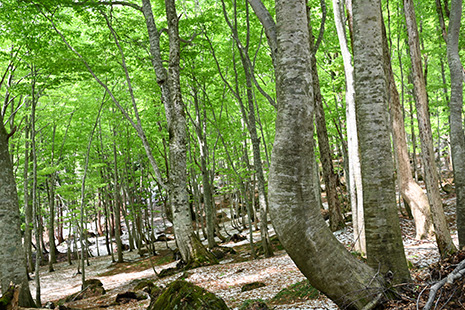
Photo: Shirakami-Sanchi World Heritage Conservation Center
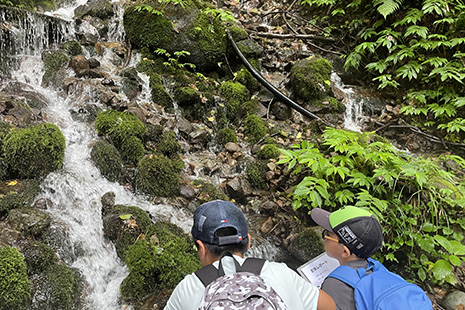
Photo: Shirakami-Sanchi World Heritage Conservation Center
In addition to the forests, Shiratori also recommends Shirakami’s abundant streams.
“Aside from the forests, the many streams provide a different look for the Shirakami-Sanchi Mountains. One place you can enjoy delicious stream water is at the heart of the Dakedai Education Forest. Shirakami-Sanchi has some of the softest water in Japan and tastes mild and delicious even when it’s cold. I hope people can experience it when they come visit.”
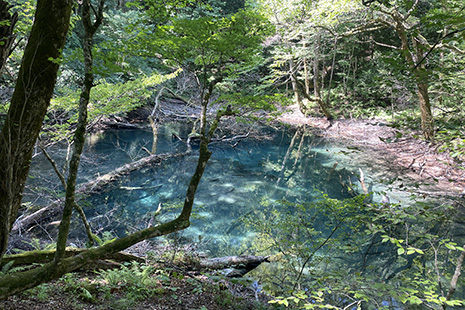
Photo: Shirakami-Sanchi World Heritage Conservation Center
She also recommends that overseas visitors take a look at the cedar forests in the village before going into the mountains.
“Cedar is actually endemic to Japan, and Shirakami-Sanchi is a place where natural cedar grows wild over a wide area. The historical presence of cedar as an important commodity timber and industry in northern Tohoku may also interest overseas visitors.”
She also wants visitors to enjoy the changes and differences between the coniferous cedar trees that adorn the satoyama (undeveloped mountain-village border zone) and the broad-leaf Japanese Beech trees that rise up deep in the mountains. Visitors will see the charm of both and experience a deeper enjoyment of Japan’s forests.

Photo: Shirakami-Sanchi World Heritage Conservation Center
* UNESCO inscribes three types of World Heritage sites: (1) Cultural Heritage; (2) Natural Heritage; and (3) Mixed Heritage, which combines both Cultural and Natural Heritage values.
** A forest consisting of a single species of tree. Also called “simple forest.” In this case, the term “tree species” refers only to tall trees, and excludes shrubs and flowering plants.
*** A facility established by the Ministry of the Environment in 1998 in Fujisato Town, Akita Prefecture. The facility exhibits materials related to the nature of Shirakami-Sanchi and details about it as a World Heritage site, and has nature advisors on hand.
**** In 2024 and 2025, only open in autumn.
***** Open only for guided tours.
****** Open from May to November.
******* Open from April to December.
By Morohashi Kumiko
Photo: Shirakami-Sanchi World Heritage Conservation Center; PIXTA
